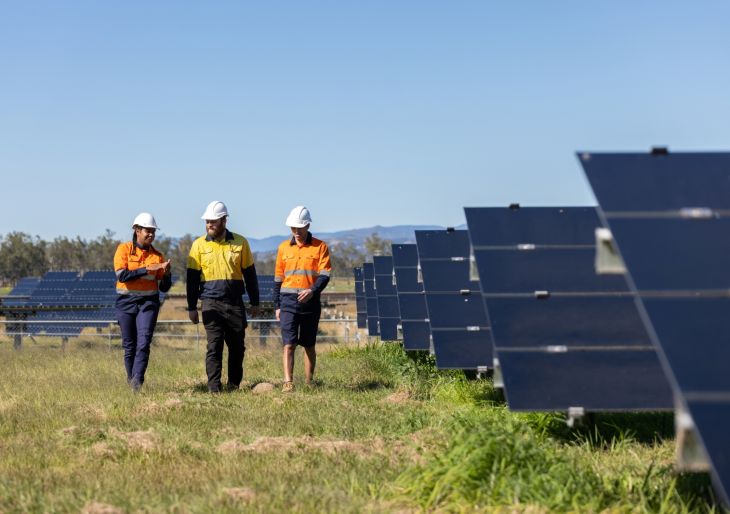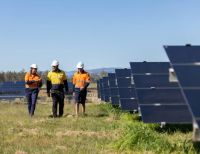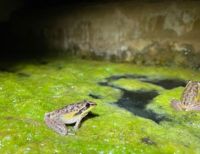Australia lags the US and Canada when it comes to involving Indigenous people in projects on their land. With the growth of renewable energy, we have an opportunity to make a fresh start.
Research shows that Aboriginal land holders want to be part of the energy transition. But they need support and resources. Photo: Getty Images/Thurtell
Australia’s plentiful solar and wind resources and proximity to Asia means it can become a renewable energy superpower. But as the renewable energy rollout continues, Aboriginal and Torres Strait Islander people must benefit.
Renewables projects can provide income and jobs to Aboriginal land owners. Access to clean energy can also help First Nations people protect their culture and heritage, and remain on Country.
This is not a new idea. Policies in the United States and Canada, for example, actively seek to ensure the energy transition delivers opportunities to Indigenous people.
The Australian government is developing a First Nations Clean Energy Strategy and is seeking comment on a consultation paper. Submissions close February 9. If you feel strongly about the issue, we urge you to have your say.
We must get this policy right. Investing meaningfully in First Nations-led clean energy projects makes the transition more likely to succeed. What’s more, recognising the rights and interests of First Nations people is vital to ensuring that injustices of the past are not repeated.
A video by author Adam Fish exploring the Eastern Kuku Yalanji community of Wujal Wujal in Queensland and their struggle for renewable energy..
Good for business, and people
Indigenous peoples have recognised land interests covering around 26% of Australia’s landmass. Research shows Aboriginal land holders want to be part of the energy transition. But they need support and resources.
This could take the form of federal grants to make communities more energy-efficient or less reliant on expensive, polluting diesel generators. Funding could also be spent on workforce training to ensure First Nations people have the skills to take part in the transition. Federal agencies could be funded to support grants for First Nations feasibility studies of renewable energy industry on their land.
As well as proper investment, governments must also ensure First Nations people are engaged early in the planning of renewable projects and that the practice of free prior and informed consent is followed. And renewable energy operators will also need to ensure they have capability to work with First peoples.
The First Nations Clean Energy Network – of which one author, Heidi Norman, is part – is a network of First Nations people, community organisations, land councils, unions, academics, industry groups and others. It is working to ensure First Nations communities share the benefits of the clean energy boom.
The network is among a group of organisations calling on the federal government to invest an additional A$100 billion into the Australian renewables industry. The investment should be designed to benefit all Australians, including First Nations people.
In Australia, the Albanese government has set an emissions-reduction goal of a 43% by 2030, based on 2005 levels. But Australia’s renewable energy rollout is not happening fast enough to meet this goal. Climate Change Minister Chris Bowen has called for faster planning decisions on renewable energy projects.
To achieve the targets, however, the federal government must bring communities along with them – including First Nations people.
As demonstrated by the US and Canada, investing meaningfully and at scale in First Nations-led clean energy projects is not just equitable, it makes good business sense.
Follow the leaders
The US Inflation Reduction Act of 2022 made A$520 billion in investments to accelerate the transition to net zero. Native Americans stand to receive hundreds of billions of dollars from the laws. This includes funding set aside for Tribal-specific programs.
Canada is even further ahead in this policy space. In fact, analysis shows First Nations, Métis and Inuit entities are partners or beneficiaries of almost 20% of Canada’s electricity-generating infrastructure, almost all of which is producing renewable energy. In one of the most recent investments, the Canadian government in 2022 invested C$300 million to help First Nations, Inuit and Métis Peoples launch clean energy projects.
Policymakers in both countries increasingly realise that a just transition from fossil fuels requires addressing the priorities of First Nations communities. These investments are a starting point for building sustainable, globally competitive economies that work for everyone.
As US and Canada examples demonstrate, the right scale of investment in First Nations-led projects can mean fewer legal delays and a much-needed social licence to operate.
Dealing with the climate risk
First Nations people around the world are on the frontline of climate change. It threatens their homelands, food sources, cultural resources and ways of life.
First Nations have also experienced chronic under-investment in their energy infrastructure by governments over generations, both in Australia and abroad.
Investing in First Nations-led clean energy projects builds climate resilience. This was demonstrated by the federal government’s Bushlight program, which ran from 2002 to 2013. It involved renewable energy systems installed in remote communities in the Northern Territory, Western Australia and Queensland.
Bushlight’s solar power meant that communities were not dependent on the delivery of diesel. So they still had power if roads were closed by flooding or other climate disasters.
Australia must get moving
The Biden government’s Inflation Reduction Act prompted a swift reaction from governments around the world. But after 15 months, Australia is yet to respond or develop equivalent legislation.
We must urgently develop our response and seize this unique opportunity to become world leaders in the global renewables race. That includes ensuring First Nations participate in and benefit from these developments.
The First Nations Clean Energy Strategy consultation paper can be found here. Feedback can be provided here.

Adam Fish, Associate Professor, School of Arts and Media, UNSW Sydney and Heidi Norman, Professor, Faculty of Arts, Design and Architecture, UNSW Sydney
This article is republished from The Conversation under a Creative Commons license. Read the original article.







